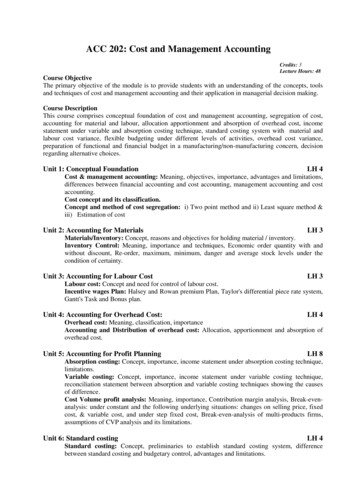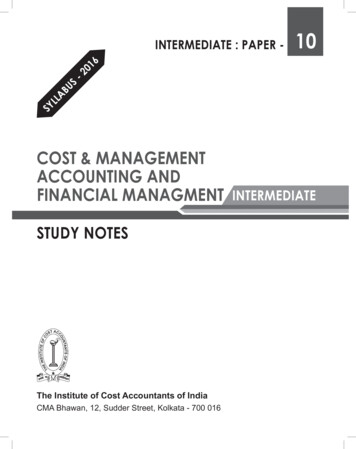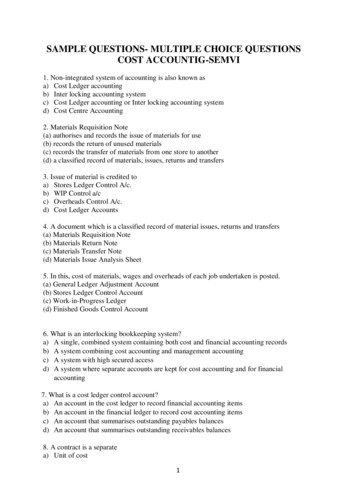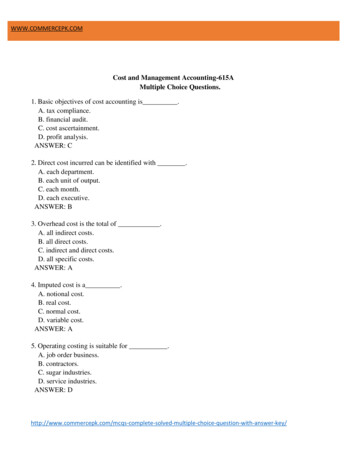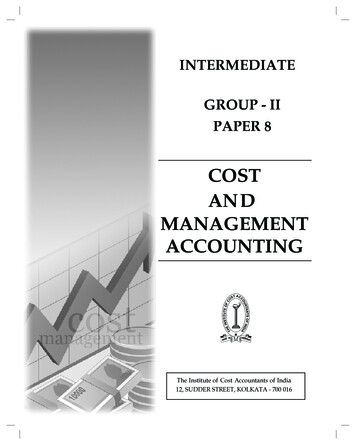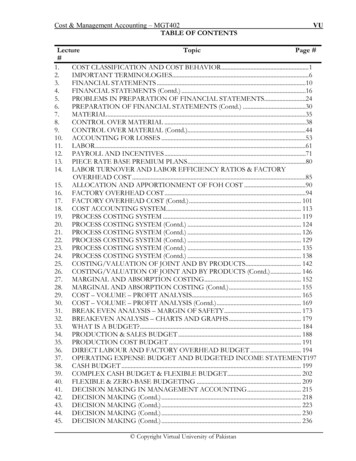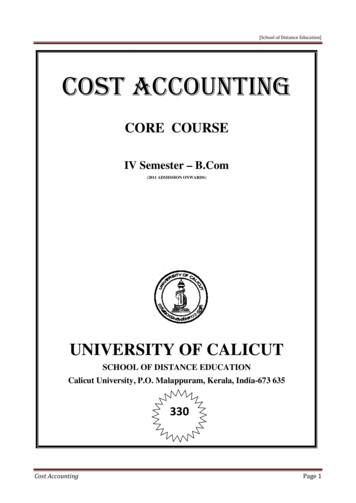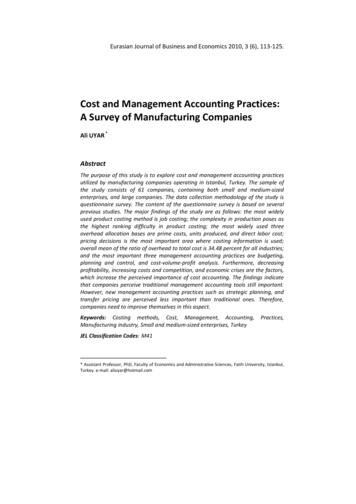
Transcription
Eurasian Journal of Business and Economics 2010, 3 (6), 113-125.Cost and Management Accounting Practices:A Survey of Manufacturing CompaniesAli UYAR *AbstractThe purpose of this study is to explore cost and management accounting practicesutilized by manufacturing companies operating in Istanbul, Turkey. The sample ofthe study consists of 61 companies, containing both small and medium-sizedenterprises, and large companies. The data collection methodology of the study isquestionnaire survey. The content of the questionnaire survey is based on severalprevious studies. The major findings of the study are as follows: the most widelyused product costing method is job costing; the complexity in production poses asthe highest ranking difficulty in product costing; the most widely used threeoverhead allocation bases are prime costs, units produced, and direct labor cost;pricing decisions is the most important area where costing information is used;overall mean of the ratio of overhead to total cost is 34.48 percent for all industries;and the most important three management accounting practices are budgeting,planning and control, and cost-volume-profit analysis. Furthermore, decreasingprofitability, increasing costs and competition, and economic crises are the factors,which increase the perceived importance of cost accounting. The findings indicatethat companies perceive traditional management accounting tools still important.However, new management accounting practices such as strategic planning, andtransfer pricing are perceived less important than traditional ones. Therefore,companies need to improve themselves in this aspect.Keywords: Costing methods, Cost, Management, Accounting,Manufacturing industry, Small and medium-sized enterprises, TurkeyPractices,JEL Classification Codes: M41* Assistant Professor, PhD, Faculty of Economics and Administrative Sciences, Fatih University, Istanbul,Turkey. e-mail: aliuyar@hotmail.com
Ali UYAR1. IntroductionThe importance of cost and management accounting practices has increased morethan ever. The reasons for this are the domestic and global competition gettingseverer by globalization, decreasing profit margins, increasing input prices due thetightening energy sources, economic crises etc. Therefore, companies operating indeveloping countries have also begun to implement cost and managementaccounting practices which were first adopted by companies operating indeveloped countries. Parallel to these developments, research studies which havebeen conducted initially in developed countries are followed by the studies1conducted in developing countries . However, Lin and Yu (2002) states that theapplication of management accounting in less developed countries remainsunsatisfactory and studies on this area are rare in the literature. They add saying“this may be due to the relatively under-developed status of economic andbusiness administration in less developed countries”.Based on the economic developments, Turkish accounting profession has been inprogress since the establishment of Turkish Republic (Aysan, 2006). As a result ofindustrialization, the need for accounting profession emerged (Aysan, 2006). Forthis reason, the business managers and management accountants needed inprivate companies were mostly transferred from State Economic Enterprises(Aysan, 2006). In the last decades, cost and management accounting has gainedimportance as private sector developed in almost all areas. Large industrialenterprises set up cost and management accounting segments in accountingdepartments. Furthermore, curricula of faculties of economics and administrativesciences included cost accounting and/or management accounting along withfinancial accounting.The purpose of this study is to explore cost and management accounting practicesutilized by manufacturing companies operating in Istanbul, Turkey. Although thereare some published papers on cost and management accounting practices inTurkish national scientific journals of accounting, and economics and administrativesciences, there are not at all publications in international journals. This paper aimsto fill in this gap. The findings are expected to contribute to the existing literatureabout the subject, especially in developing markets.The remainder of the paper is organized as follows. Section two provides literaturereview. Section three explains the objectives of this study. Section four providesscope and methodology of the study. Section five presents analysis andinterpretation. Summary and conclusion takes place in sixth section. Finally, scopefor further research is presented in the last section.1Some authors have used terms “less developed countries”, “newly industrialized countries”, “emergingnations”, “emerging markets” and “transitional economies” interchangeably for developing countries(Budhwar, P.S. and Debrah, Y.A., (2003), Human Resource Management in Developing Countries,Routledge, p.4.)Page 114EJBE 2010, 3 (6)
Cost and Management Accounting Practices: A Survey of Manufacturing Companies2. Literature reviewParallel to increasing importance of management accounting practices in achievingorganizational goals, studies conducted in this field have increased in recent yearsin emerging markets (Wu et al. 2007; O'Connor et al., 2004; Joshi, 2001; Szychta,2002) following the studies conducted in developed markets (Wijewardena andZoysa, 1999; Chenhall and Langfield-Smith, 1998; Guilding et al., 1998; Shields,1998).In a study conducted on 40 industrial companies in Egypt, Van Triest and Elshahat(2007) concluded that cost accounting information in Egypt is available at a basiclevel, and used more for external (pricing) purposes than for internal (performance)purposes. They also found that the use of advanced cost accounting techniquessuch as activity-based costing system seem absent. The comparative studyconducted by Joshi (2001) revealed that Indian manufacturing companies relyheavily on the traditional management accounting techniques such as variablecosting, budget for day-to-day operations, capital budgeting tools, return oninvestment based performance evaluation, and performance evaluation. However,the adoption rates of recently developed practices such as shareholders’ valueanalysis, performance evaluation (qualitative measures), product life cycle costing,back flush costing, activity based budgeting, value chain analysis, benchmarkingand balanced scorecard, have been rather low and slow. Meanwhile, some studieshave shown that size has a major influence in determining the adoption of newlydeveloped cost and management accounting practices; adoption rates are muchhigher in larger firms (Joshi, 2001; Chenhall, and Langfield-Smith, 1998).Parallel to the developments in other countries, implementation of cost andmanagement accounting practices are gaining momentum in Turkey. Number ofbooks and journal articles published about the subject is increasing everydayparallel to these developments as well. There have been many published cost andmanagement accounting books since 1950s. Following works can be cited amongthem: Akdoğan (2009), Altug (1982, 1985), Bursal (1968, 1990), Buyukmirza (1977,1985, 1987, 2007), Sevgener (1986), Karakaya (2007), Ustun (1984, 1985, 1988),Caldag (2008), Gursoy (1999), Guredin et al. (2007) and Hacirustemoglu (1999).These works cover cost classifications, allocation of costs, product costing methods(i.e. job costing, process costing, activity-based costing), standard costing,budgeting, break-even analysis, and other topics in cost and managementaccounting.In addition, researches about cost and management accounting practicesconducted by academicians have been published in national academic journals. Astudy, which was conducted on 51 companies from largest 500 industrialenterprises for 2002 in Turkey, showed that (1) 29.5 percent of the respondentsutilize process costing, followed by activity-based costing (25.5 percent) and jobcosting (23.5 percent), (2) direct materials cost has the largest portion inEJBE 2010, 3 (6)Page 115
Ali UYARmanufacturing costs, followed by manufacturing overhead and direct labor costs,(3) the most widely used overhead allocation base is units produced (30 percent),followed by direct labor hours (23 percent), direct machine hours (15 percent), (4)the most frequently used management accounting practices are cost-volume-profitanalysis (72.6 percent), strategic profitability analysis (47.1 percent), flexiblebudgeting (45.1 percent), and customer profitability analysis (45.1 percent) (Ersoyet al., 2006).Another study conducted in Kayseri, which is one of the leading industrialprominences of Turkey, showed that 22 companies out of 30 (73.3 percent) useprocess costing, 7 companies (23.3 percent) use job costing, and 1 company (3.3percent) uses both (Ayyıldız and Durna, 2005). This study showed that the mostwidely used overhead allocation bases are units produced (43.2 percent), followedby direct labor costs (37.8 percent).According to the third study conducted recently in another industrial province,Denizli in Turkey, 30 companies out of 86 (35 percent) use process costing, 23companies (27 percent) use job costing, and 17 companies (20 percent) use bothmethods (Uyar, 2008). The same study showed that most widely used overheadallocation base is units produced (45 companies out of 86), followed by directmaterial costs (14 companies out of 86), direct machine hours (7 companies out of86), and direct labor costs (7 companies out of 86). Another important finding ofthis study is that the largest share in manufacturing costs belongs to directmaterials costs.3. Objectives of the studyThe objective of this study is to explore cost and management accounting practicesutilized by manufacturing companies operating in Istanbul, Turkey. The paper isexpected to contribute to the existing literature about the subject, especially indeveloping markets. The paper primarily investigates the following points: productcosting methods used by the companies; difficulties faced in product costing;overhead allocation bases used by the companies; usage areas of costinginformation; the reasons which increase the perceived importance of costaccounting; and management accounting practices usage.4. Scope and methodologyThe data for this study was obtained by means of a survey questionnaire conductedface-to-face with 61 randomly chosen manufacturing companies in Istanbul fromvarious industries. The questionnaire includes multiple choice, open-ended, andLikert scale questions. Some questions of the survey were adopted form variousprevious studies (Brierly et al., 2001; Van Triest and Elshahat, 2007; Wijewardenaand Zoysa, 1999). The data collection period ranges from January 2008 to April2008.The questionnaire consists of two parts:Page 116EJBE 2010, 3 (6)
Cost and Management Accounting Practices: A Survey of Manufacturing Companies(1) general information on the business organizations and respondents; and(2) cost and management accounting practices.Table 1 presents information gathered from the first part of the questionnaire.Table 1. Profile of the respondentsIndustry ClassificationTextilePaper Products and PublicationChemicals and PlasticsFoodMiscellaneousTotalSize (Annual Sales)Less than 25.000.000 TL25.000.000-50.000.000 TLMore than 50.000.000 TLTotalOwnership Structure100 percent DomesticDomestic-ForeignTotalPosition of RespondentOwnerGeneral ManagerControllerFiscal ManagerCost AccountantCertified Public AccountantMissingTotalNumber of Employees10-4950-249250 TotalAge of FirmLess than 10 years10-20 yearsMore than 20 .363.914.8100.01723216127.937.734.4100.0In the Table 1, industry classification, size of the firms (in terms of annual sales),ownership structure, position of respondent, number of employees, and age offirms are presented. In the industry classification, the highest percentage belongsto textile industry (26 firms), and “miscellaneous” includes firms operating ininformation technology (1 firm), leather and shoes (2 firms), unknown (1 firm),EJBE 2010, 3 (6)Page 117
Ali UYARconstruction (1 firm), metal (2 firms), wood products (1 firm), automotive (1 firm),and cotton (1 firm) in industry classification. Most of the respondents (85.2percent) are small and medium-sized enterprises (according to the number ofemployees), domestically owned, and more than ten-year old. 65.6 percent of therespondents have annual sales less than or equal to 50.000.000 Turkish Liras (TL).The average export/sales ratio of the respondents is 41.7 percent.5. Analysis and interpretation5.1. Product costing methodsIn the second part of the questionnaire, the respondents were asked to specify themethods they implement in product costing. According to the answers, the mostwidely used costing method is job costing (31 firms), followed by activity-basedcosting (19 firms) and process costing (7 firms). In Table 2, which shows thedetailed answers to this question, the most significant points are the usage of jobcosting widely by textile industry, and the usage of activity-based costing largely bychemicals and plastics industry. Possible reason for the usage of job costing bycompanies is that they manufacture distinct products.Table 2. Product costing methodsIndustryTextilePaper Products and PublicationChemicals and PlasticsFoodMiscellaneousNot 17ABCNotspecified4181519Total22911510461445.2. Difficulties faced in product costingThe respondents were also asked to point out the difficulties they encounter inproduct costing. Out of 42 respondents, 22 companies see the complexity inproduction as the highest ranking difficulty (52.4 percent), followed by lack ofneeded information (33.3 percent), and lack of necessary software (14.3 percent).5.3. Overhead allocation bases used to calculate product costsTable 3 shows the details of the answers given to the question “Which overheadallocation bases are used in product costing in the business?”. The most widelyused overhead allocation bases are prime costs (65.6 percent), units produced(19.7 percent), and direct labor cost (19.7 percent). The table presents the findingsof some other studies about cost allocation basis. Prime costs which is the mostwidely used allocation base is not stated in other studies, therefore, a comparisonis not made. Comparison of other allocation basis indicates mixed results. Usagepercentages of cost allocation basis differ from country to country. However, in thePage 118EJBE 2010, 3 (6)
Cost and Management Accounting Practices: A Survey of Manufacturing Companiestextbook written by Horngren et al. (2000, p. 101), direct labor hours is the mostwidely used overhead allocation base among the countries United States, Australia,Ireland, Japan, and United Kingdom.Table 3. Overhead allocation bases used to calculate product costsUnitedaFrequency PercentIrelandbOverhead ratesKingdomDirect labor hour914.8%39%19.2%Direct labor cost (DLC)1219.7%13%4.7%Machine hour711.5%22%22.5%Units produced1219.7%28%19.4%Direct material cost (DMC)34.9%7%8.1%DMC DLC (Prime costs)4065.6%Other22%26.1%abcClarke (1997); Brierley, Cowton, and Drury (2001); Bjørnenak (1997)cNorway28%37%29%40%26%23%5.4. Application of costing informationIn another part of the survey, which was adopted from Van Triest and Elshahat(2007)’s study, respondents were asked to score the use and application of costinginformation on a Likert scale of 1 (never use) to 5 (always use). To evaluate theresults, one sample t-test was conducted (Table 4). The results showed that pricingdecisions are the most important area where costing information is used at anaverage of 4.16, followed by customer profitability and activity analysis at 4.07.Performance measurement and make or buy decisions with an average of 4.04 and3.96 respectively are also important areas where costing information is used.However, costing information is not used in product mix decisions, and adding ordeleting products as much as other areas.Table 4. Results of one sample t-test for application of costing information(Test value 3.5)PurposePricing decisionsCustomer profitabilityPerformance measurementActivity analysisMake or buy decisionsProduct mix decisionsAdding or deleting products* Significant at 0.001 3.793*3.576*0.289-0.199Furthermore, the findings are compared with the results of Van Triest and Elshahat(2007). The comparison indicated that two studies yielded parallel results. As seenin Table 5, first three items with the highest mean are the same. In both countries,pricing decisions, customer profitability, and performance measurement are themost prominent areas in which costing information is applied. Among theremaining four application areas, the rank of activity analysis is different. In thisEJBE 2010, 3 (6)Page 119
Ali UYARstudy, activity analysis is the fourth in ranking, but it is the last in ranking in VanTriest and Elshahat (2007)’s study.Table 5. Comparison of results with the results of Van Triest and Elshahat(2007)PurposePricing decisionsCustomer profitabilityPerformance measurementActivity analysisMake or buy decisionsProduct mix decisionsAdding or deleting products* The results of Van Triest and Elshahat ean*4.474.204.132.383.753.302.93Rank*12374565.5. The ratio of overhead cost to total costIn the questionnaire survey, the ratio of overhead cost to total cost (OC/TC) wasalso questioned. Overall mean for all industries is 34.48 percent. In addition, OneWay ANOVA analysis (Table 6) was conducted to see the significant differencesamong industries. The results showed that there is a significant difference amongindustries (significant at 0.10). Duncan test from Post Hoc tests showed that foodindustry has the highest OC/TC ratio and is significantly different than paperproducts and publication, chemicals and plastics, and miscellaneous industries.Table 6. The ratio of overhead cost to total cost (percent)ANOVABetween GroupsWithin GroupsTotala, bDuncanSum of Squares4183.86922129.72426313.593df44448Mean Square1045.967502.948F2.080Sig.0.100NSubset for alpha .05Industry12Chemicals and Plastics925.22Paper Products and 38.07Food459.25Sig.0.3310.081Means for groups in homogeneous subsets are displayed.aUses Harmonic Mean Sample Size 7.161.bThe group sizes are unequal. The harmonic mean of the group sizes is used. Type I errorlevels are not guaranteed.Page 120EJBE 2010, 3 (6)
Cost and Management Accounting Practices: A Survey of Manufacturing Companies5.6. The reasons for the increased interest in cost accountingThe respondents were asked to score the reasons for the increased interest in costaccounting on a Likert scale of 1 (completely disagree) to 5 (completely agree). Alist of reasons was provided for the respondents so that they evaluated each. Theresults of one-sample t-test in Table 7 showed that decreasing profitability (4.59) isthe primary reason which increases the importance of cost accounting. Otherreasons which increase the importance of cost accounting are increasing costs(4.57), increasing domestic and global competition (4.30), and economic crises(4.23). Actually, means of four items above 4.00 indicate that they are all factorsconsidered important for the increased interest in cost accounting. This meansprofitability of companies is decreasing, possibly due to increasing costs, andincreasing domestic and global competition. Economic crises which hit companiesfrom time to time are also important reason for the increased interest in costaccounting.Table 7. The reasons for the increased interest in cost accounting (Testvalue 3.5)Decreasing profitabilityIncreasing costsIncreasing domestic and global competitionEconomic crises* Significant at 0.001 t14.161*11.929*6.448*5.400*5.7. Perceived importance of management accounting practicesLastly, the respondents were asked to evaluate the perceived importance ofmanagement accounting practices that are utilized in the business organizations ona Likert scale of 1 (unimportant) to 5 (very important). The results of one-sample ttest in Table 8 indicated that the most important management accounting practicesin decreasing order are budgeting (4.48), planning and control (4.33), cost-volumeprofit analysis (4.3), target costing (4.16), quality cost reporting (4.09), performancemeasurement and evaluation (4.02), responsibility accounting (4.00), standardcosting and variance analysis (3.89), and strategic planning (3.78). Transfer pricing(3.65) is unique practice that is significantly not important based on test value of3.5. These findings indicate that companies perceive traditional managementaccounting tools still important. For example, budgeting, planning and control, andcost-volume-profit analysis are perceived the most important of all managementaccounting practices. Quality costing and target costing as new managementaccounting practices are utilized by the companies. However, strategic planning,and transfer pricing are perceived the least important ones. This may be due to sizeof the sample firms. Since the sample consists mostly of small and medium-sizedenterprises (according to number of employees), some tools may be toosophisticated to be utilized. Szendi and Shum (1999) states that the larger the firmthe more sophisticated the management accounting system and the more likely isEJBE 2010, 3 (6)Page 121
Ali UYARthe firm to utilize sophisticated management accounting techniques and practices.Abdel-Kader and Luther (2008) also proved that large firms adopt moresophisticated management accounting techniques and practices than small firms.Table 8. Perceived importance of management accounting practices (Testvalue 3.5)BudgetingPlanning and controlCost-volume-profit analysisTarget costingQuality cost reportingPerformance measurement and evaluationResponsibility accountingStandard costing and variance analysisStrategic planningTransfer pricing** Significant at 0.001 level* Significant at 0.05 *3.447**2.475*2.064*0.8556. Summary and ConclusionThe survey revealed the general cost and management accounting practices ofTurkish manufacturing companies operating in Istanbul. The findings are expectedto contribute to the existing literature about the subject, especially in developingmarkets.The major findings of the study are as follows: the most widely used costing method is job costing, the complexity in production poses as the highest ranking difficulty in productcosting, the most widely used overhead allocation bases are prime costs, units produced,and direct labor cost, pricing decisions is the most important area where costing information is used(parallel to the finding of Van Triest and Elshahat, 2007), overall mean of the ratio of overhead to total cost is 34.48 percent for allindustries, the highest overhead cost/total cost ratio belongs to food industry, decreasing profitability, increasing costs and competition, and economic crisesare reasons which increase the importance of cost accounting, and the most important management accounting practices is budgeting (parallel tothe finding of Chenhall and Langfield-Smith, 1998)Page 122EJBE 2010, 3 (6)
Cost and Management Accounting Practices: A Survey of Manufacturing CompaniesThe findings indicate that companies perceive traditional management accountingtools still important. However, new management accounting practices such asstrategic planning, and transfer pricing are perceived less important thantraditional ones. Therefore, they need to improve themselves in this aspect.7. Scope for further researchSince the sample consists mostly of small and medium-sized enterprises (accordingto number of employees), they may not reflect the applications of large companiescompletely. Secondly, the results are confined to the manufacturing companies andshould not be generalized to the other sectors. Thirdly, since the survey conductedon companies operating in Istanbul, the findings may not be generalized to thewhole country.For future research, a countrywide and more comprehensive survey could beconducted with the participation of more companies from distinct industries.Moreover, case studies can be conducted to make more in-depth analysis aboutcost and management accounting practices.ReferencesAbdel-Kader, M. and Luther, R. (2008), “The impact of firm characteristics on managementaccounting practices: A UK-based empirical analysis”, The British Accounting Review, Vol. 40,No. 1, pp. 2-27.Akdoğan, N. (2009), Tekdüzen Muhasebe Sisteminde Maliyet Muhasebesi Uygulamaları, GaziKitabevi.Altuğ, O. (1982), Maliyet Muhasebesi: İlkeler ve Uygulamaları, Marmara Üniversitesi NihadSayar Yayın ve Yardım Vakfı Yayınları, 1.baskı, İstanbul.Altuğ, O. (1985), Maliyet Muhasebesi: İlkeler ve Uygulamalar, Marmara Üniversitesi NihadSayar Yayın ve Yardım Vakfı Yayınları, 2.baskı, İstanbul.Aysan, M.A. (2006), “A history of the accounting profession in Turkey”, Journal of FinancialAnalyze Special Issue Published By Istanbul Chamber Of Certified Public Accountants For17th World Congress Of Accountants, 13-16 November 2006.Ayyıldız, S.U. ve Durna, S. (2005), “Kayseri’de faaliyet gösteren işletmelerde maliyetmuhasebesi kullanılma düzeyine ilişkin bir araştırma”, Muhasebe ve Finansman, Sayı 27, pp.94-104.Bjørnenak, T. (1997), “Conventional wisdom and costing practices”, ManagementAccounting Research, Vol. 8, No. 4, pp. 367-382.Brierley, J.A., Cowton, C.J. and Drury, C. (2001), “How product costs are calculated and usedin decision making: a pilot study”, Managerial Auditing Journal, Vol. 16 No. 4, pp. 202-206.Bursal, N. (1968), Maliyet Muhasebesi: Prensipleri ve Tatbikatı, Yalkın Ofset Matbaası,İstanbul.Bursal, N. ve Ercan, Y. (1990), Maliyet Muhasebesi: İlkeler ve Uygulama, Muhasebe EnstitüsüYayınları, 3.baskı, İstanbul.Büyükmirza, K. (1977), Yönetim Muhasebesi, Bayrak Matbaası, 1.baskı, Ankara.EJBE 2010, 3 (6)Page 123
Ali UYARBüyükmirza, K. (1985), Yönetim Muhasebesi, Gazi Üniversitesi Yayınları, 2.baskı, Ankara.Büyükmirza, K. (1987), Yönetim Muhasebesi, Gazi Üniversitesi Yayınları, 3.baskı, Ankara.Büyükmirza, K. (2007), Maliyet ve Yönetim Muhasebesi: Tekdüzene Uygun Bir SistemYaklaşımı, Gazi Üniversitesi Yayınları, 11.baskı, Ankara.Caldag, Y. (2008), Maliyet ve Yönetim Muhasebesi Uygulamaları, Gazi Kitabevi.Chenhall, R.H. and Langfield-Smith, K. (1998) “Adoption and benefits of managementaccounting practices: an Australian study”, Management Accounting Research, Vol. 9, No. 1,pp. 1 – 19.Clarke, P.J. (1997), “Management accounting practices in large Irish manufacturing firms”,Irish Business and Administrative Research, Vol. 18, pp. 136-152.Donmez, A., Berberoglu, P.B., Utku, B.D., ve Ersoy, A. (2006), “Yönetim muhasebesininkavramsal gelişim sürecinin değerlendirilmesi”, Akdeniz İ.İ.B.F. Dergisi, Sayı 11, pp. 178-203.Ersoy, A., Utku, B.D., Dönmez, A. ve Berberoglu, B. (2006), “Üretim işletmelerinde yönetimmuhasebesi konularının uygulanmasına ilişkin bir araştırma”, Muhasebe ve FinansmanDergisi, Sayı 32, pp. 50-60.Guilding, C., Lamminmaki, D. and Drury, C. (1998), “Budgeting and standard costing practicesin New Zealand and the United Kingdom”, The International Journal of Accounting, Vol. 33No. 5, pp. 569-588.Guredin, E.,Ulker Ayyıldız, M.S. and Burgazlıoğlu, E. (2007), Uygulamalı Maliyet ve YönetimMuhasebesi, Arikan Basim Yayim Dagitim.Gursoy, C.T. (1999), Yönetim ve Maliyet Muhasebesi, Beta Basım Yayım.Hacirustemoglu,R. (1999), Yönetim Muhasebesi Uygulamaları, 3. baski, Alfa Yayinevi.Horngren, C. T., Datar, S. M. and Foster G. (2000), Cost Accounting: A Managerial Emphasis,10th ed., Pearson Prentice Hall, New Jersey.Joshi, P.L. (2001), “The international diffusion of new management accounting practices: thecase of India”, Journal of International Accounting, Auditing and Taxation, Vol. 10 No.1, pp.85-109.Karakaya, M. (2007), Maliyet Muhasebesi, Gazi Üniversitesi Yayınları, 3.baskı, Ankara.Lin, Z.J., and Yu, Z. (2002), “Responsibility cost control system in China: a case ofmanagement accounting application”, Management Accounting Research, Vol. 13, Iss. 4, pp.447-467.O'Connor, N.G., Chow, C.W., Wu, A. (2004), “The adoption of “Western” managementaccounting/controls in China’s state-owned enterprises during economic transition”,Accounting, Organizations and Society, Vol. 29 No.3/4, pp. 349-75.Sevgener, S. (1986), Yönetim Muhasebesi, Marmara Üniversitesi Eğitim ve Yardım VakfıYayınları, 1.baskı, İstanbul.Shields, M. D., (1998) “Management accounting practices in Europe: a perspective from theStates”, Management Accounting Research, Vol. 9, No. 4, pp. 501-513.Szendi, J.Z. and Shum, C. (1999), “Strategic management accounting practices in LatinAmerica”, Journal of Accounting and Finance Research, Vol. 7, No. 1, pp. 1-13.Szychta, A. (2002), “The scope of application of management accounting methods in Polishenterprises”, Management Accounting Research, Vol. 13, No. 4, pp. 401-418.Page 124EJBE 2010, 3 (6)
Cost and Management Accounting Practices: A Survey of Manufacturing CompaniesUstun, R. (1984), Maliyet Muhasebesi: İlkeler ve Uygulamalar, Anadolu Üniversitesi Basımevi,1.baskı, Eskişehir.Ustun, R. (1985), Maliyet Muhasebesi: İlkeler ve Uygulamalar, Bilim Teknik Yayınevi, 2.baskı.İstanbul.Ustun, R. (1988), Maliyet Muhasebesi: İlkeler ve Uygulamalar, Bilim Teknik Yayınevi, 3.baskı,İstanbul.Uyar, S. (2008), “Denizli’de faaliyet gösteren üretim işletmelerin
the most frequently used management accounting practices are cost-volume-profit analysis (72.6 percent), strategic profitability analysis (47.1 percent), flexible budgeting (45.1 percent), and customer profitability analysis (45.1 percent) (Ersoy et al., 2006). Another study conducted in Kayseri, which is one of the leading industrial .


